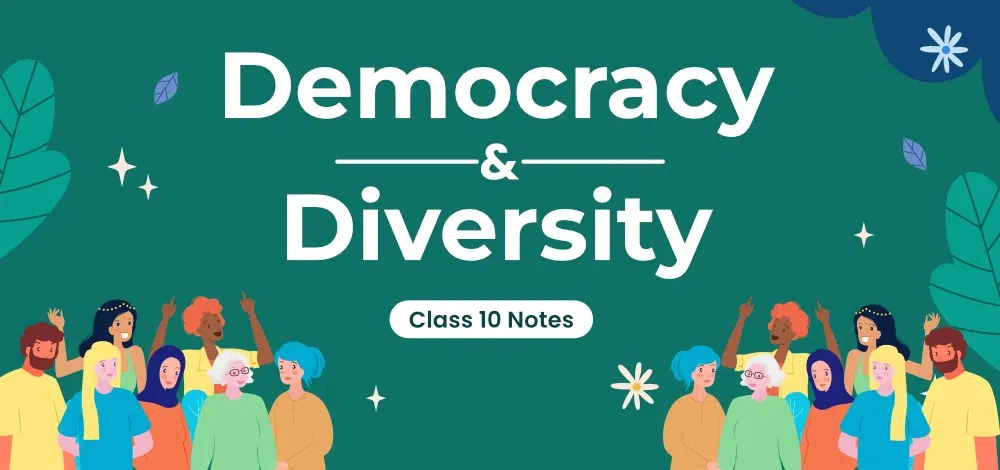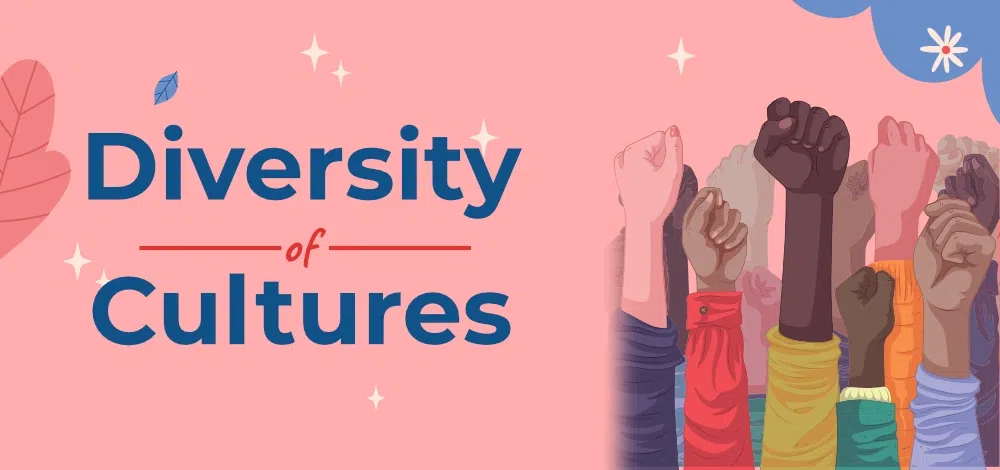Democracy and Diversity Class 10 Notes explores the concept of Racial discrimination and diversity in the democratic system. This chapter will highlight how different people like to identify themselves as belonging to different social communities. It will help the students understand how a country’s citizens see themselves based on differences. These differences include color, gender, physical appearance, tribe, caste, etc. Linguistics and ethnicity can also create a sense of difference among individuals. There is also some important information on how a state or a governmental body reacts to these social divisions. To know more, go through the topic in detail below.
You can also check CBSE Class 10 Social Science Notes where you can find the chapters of Geography, History, Civics, and Economics all in one place.

Democracy and Diversity
Democracy and Diversity Class 10 Civics Notes Chapter 3
These Class 10 Civics Chapter 3 Notes involve a lot of topics which are highlighted below and all the relevant information is given inside the topic according to the latest CBSE exam pattern.
- A Story from Mexico Olympics
- Differences, Similarities, and Divisions
- Politics of Social Divisions
A Story from Mexico Olympics
In the 1968 Mexico Olympics, two African-American athletes, Tommie Smith, and John Carlos, protested against racism. They received gold and bronze medals in the 200 meters race. During the medal ceremony, both the players raised their black-gloved fists towards the sky at the time of the US National Anthem, the black-gloved raised clenched fists meant Black Power. These fists symbolized black power amid the racism of America. They received their medals without shoes to symbolize black poverty. Peter Norman, a white Australian athlete who won the silver medal, supported the two Americans by wearing a human rights symbol on his shirt during the ceremony. It was considered a landmark in the history of the Civil Rights Movement in the United States.
Differences, Similarities, and Divisions
Social differences are mainly based on those factors that can not be changed. These factors are determined at the time of birth. The story from Mexico Olympics is an example of both social inequalities and social divisions. For instance, gender, height, skin complexion, physical ability or disabilities, religion, and caste are some of them that we cannot choose. Our upbringing and family experience plays a huge role in firmly shaping these differences in our mind. Initially, social divisions start from these factors.

Diversity of Cultures
Social differences start to grow to accumulate or combine these social differences. Or when multiple social divisions overlap, they give birth to social differences. Social differences may divide the citizens of a country, but they are also helpful in making strong united social groups. Their similarities and differences construct the boundaries of these groups.
Social differences can also discriminate against a group based on racial, social, or economic discrimination. Here are two types of social differences- overlapping and cross-cutting differences.
When a group of people starts to feel like a different community, and one type of social difference appears to be more important than the other, it is called overlapping differences. For example, Northern Ireland had two dominating Christian communities- 44% were Catholics, and 53% were Protestants. The Catholics wanted to join The Republic of Ireland, while the Protestants wanted to be attached to the United Kingdom. As a result of this difference, a violent situation broke out where thousands of people were killed. Finally, in 1998, a peace treaty embedded the violence.
Racial differences between black and white can be considered social differences in America. Generally, blacks are poorer and dominated by whites, much wealthier and more educated than blacks. So the blacks consider themselves as belonging to different communities.
Origins of Social Differences
Social differences mainly start to grow from the time of birth. Some social differences can’t be changed, like gender, complexions, physical appearance, etc. But some social differences are based on choices like religion, career, occupation, or social activities. But these cumulatively create social differences that can often lead to social divisions.
However, not all social differences are responsible for social divisions. It is already discussed that social differences are much bearable when people accept their differences and similarities by uniting themselves with an identity. In the case of the Mexico Olympics, the silver medalist Norman doesn’t belong to the black community. But he still supported Smith and Carlos, sharing the same belief about racial discrimination.
Overlapping & Cross-Cutting Differences
Social differences can turn into social division when multiple differences overlap. People generally share a common belief or interest in an issue in social differences. But when those communities started to feel deprived, social division could occur.
In India, Dalits generally belong to low-income families and face this discrimination. When social divisions intersect, groups with similar interests in one subject will likely have opposing positions on another. In Northern Ireland, the conflict between the Protestants and Catholics began from this mentality.
Cross-Cutting social differences are easier to handle. This social division is common to every country, whether big or small.
Politics of Social Divisions
The consequence of combining politics with social divisions can be very dangerous. But sometimes competition among different political parties leads them to highlight the social division and differences in a country, and they may Kindle up the possibilities of violence and disintegration. However, political surveillance on social divisions can be healthy for democracy. As a result, disadvantaged groups can open up with their grievances, and the government can make necessary decisions.
However, using social differences in competitions can result in extreme violence, which happened in Yugoslavia. Yugoslavia broke into six sovereign republics due to political rivalry along ethnic and religious lines. However, not every instance of socioeconomic and political differences results in such catastrophes. Yet, it impacts voting in most nations, particularly India.
What can be The Range of Outcomes of Politics of Social Division?
In case of the Northern Ireland, the differences between the two major sectors of Christianity; including 53% of Protestants and 44% of Roman Catholics took the essential form of politics. Catholics were represented by Nationalistic parties, who demanded for Northern Ireland be unified with the Republic of Ireland, which was a predominated Catholic country, and protestants were represented by Unionists, who wanted to be with the UK, which was predominantly Protestants. Later times, it took a drastic turn; which led to the killing of many people.
Similarly, in the case of Yugoslavia, the political competition had led to religious ending ethnic lines; which led to the disintegration of Yugoslavia into six independent countries every expression of social divisions in politics led to such disasters and affected the voting in most countries, like that of India.
Three Determinants:
3 important factors are important for deciding the outcomes of the politics of social divisions include:
- The outcome depends on people perceive their own identities and if people see their own identities in singular and more exclusive terms, it becomes a little difficult to find a solution.
- Dependence on how the political leaders are able to raise the demands of any community. It is much easier to accommodate demands which can either be a constitutional framework or not at the cost of other communities.
- It depends on the reaction of the government to the demands of the various groups.
The political expression in case of social divisions has to be very normal as well as very healthy. This allows for the various disadvantaged as well as marginal social groups the expression of their grievances and also for the government to attend to the same.
Conclusion
However, in a democratic system, political regress towards a specific social division is normal. As a result, this marginal group can come forward with their grievances. However, the excessive use of it can be dangerous for a country.
Albeit, social divisions are very regular and can be healthy for democracy. It helps to strengthen democracy by canceling the harmful demands and bringing a positive attitude towards diversity and marginalization. Democracy is the best way to shelter variety against all inequalities. So the part of violence should always be avoided to keep democracy intact.
Also Read:
Politics of Social Divisions
FAQs on Democracy and Diversity Class 10 Notes Civics Chapter 3
Q1: What is The Difference Between Democracy and Diversity?
Answer:
In a democracy, everyone is entitled to the same rights—the right of citizens to choose their representatives. Contrarily, societal diversity refers to variations in region, culture, language, and religion. Diversity begins with a person’s birth or personality.
Q2: Discuss Three Factors That Determine The Outcomes of Politics of Social Divisions?
Answer:
Social diversity’s political expression is influenced by three things.
- How individuals view their identities.
- The manner in which political leaders amplify community demands.
- The way in which the government meets a community’s requests.
Q3: Who were the “Dalits”?
Answer:
Dalit was used to refer to those in Indian society as the members who belong to a wide range of lower-caste Hindu groups and the people who come outside the caste system.
Like Article
Suggest improvement
Share your thoughts in the comments
Please Login to comment...